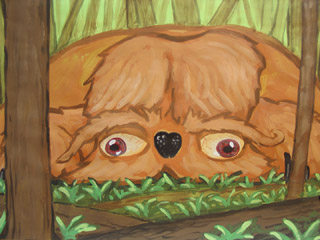you are here [x]: Scarlet Star Studios > the Scarlet Letters > From North Korea: The Giant Mupp
<< before
E - The Elysian Zorn
after >>
F - The Flightless Goan
October 6, 2007
From North Korea: The Giant Mupp
by sven at 8:00 am
Reprinted with permission from Professor Ichbonnsen's Monster Month blog.

The Giant Mupp is a species of dog native to Korea. Early in its lifespan, the animal is indistinguishable from a common street mongrel. However, as it ages, a remarkable difference becomes apparent.
The Giant Mupp lacks the genetic coding that turns off physical growth. As each year passes, it simply gets bigger and bigger. Furthermore, it also lacks the related code that produces senescence -- meaning that there is no significant metabolic deterioration as it ages. Theoretically, the animal could live forever.
Only one factor limits the Mupp: gravity. When it reaches the size of an African Elephant, the sheer weight of its flesh cripples the dog's ability to walk; only by crawling on its belly is it able to move about. As the Mupp becomes even larger than this, it will ultimately become stranded in one spot.
The animal would starve to death at this point, were it not for a very unusual adaptation. The tongue begins to grow at a faster rate than the rest of the body. The Giant Mupp is able to press this organ down into the ground, and begins absorbing nutrients from the soil beneath it. Over time, the tongue actually splits and forks into many branches -- until it resembles nothing so much as a tree's root system.
But gravity always wins. As a Mupp's eyes get larger and larger, they become distorted by their own weight, flattened out. Eventually, the membranes are too weak to contain their vitreous humor, and the dog's eyeballs burst. The Mupp can live on, blinded, but other internal organs will inevitably meet the same fate. Life ends.
Stories have been told of Mupps sixty feet wide and thirty feet tall being mistaken for hills. Animals of this size, however, have not been seen for several centuries -- and likely won't be seen again. It is estimated that the largest Giant Mupps that ever existed lived to approximately 600 years. Few today, however, ever even become noticeably large.
For generations, the meat of Mupp was considered a delicacy in Korea. Due to its popularity, the native population was almost wiped out. Farmers who bred Giant Mupps in captivity harvested the animals at earlier and earlier ages, until little difference remained between the size of the Mupps being consumed and other dogs. The practice of breeding Mupps died out; the few remaining specimens have mostly been assimilated into the general street mongrel population.
Giant Mupps as distinct species lasted somewhat longer in China. During the early dynasties, Mupps were exported to China to serve as imposing imperial guardians. The "Foo Dog" has mistakenly been identified by some as a Chinese representation of the Lion. Not so! As "magic" protectors for homes of the rich, few were entrusted with the truth of the animal's origins -- but I have personally met with certain old families remaining in possession of scrolls that provide enlightenment on this matter.
It has been rumored that there are at least two Giant Mupps surviving within China's borders. It is also likely that there are still some genetically pure Mupps left in Korea, which have escaped into far-flung wooded areas.
posted by sven | October 6, 2007 8:00 AM | categories: bestiary